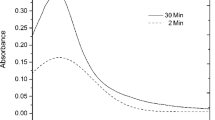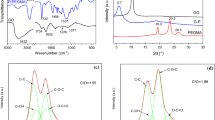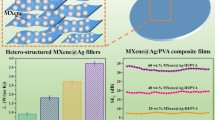Abstract
Polyethylene terephthalate (PET) based elastomers have witnessed increasing applications in various emerging fields, and the crystallization modification of the PET-based elastomers with functional nanoparticles is considered as the effective strategy for simultaneously improving their processing efficiency, mechanical properties as well as functionalities. Therefore, we herein have synthesized a range of silver nanoparticles (Ag NPs) with different sizes using a high temperature resistance polymer as the surface capping agent. Furthermore, we found that the melt crystallization of a semi-crystallized PET-based elastomer, which was obtained by introducing the flexible polyethylene glycol (PEG1000) segment into PET backbone via condensation polymerization, can be effectively tuned by the synthesized Ag NPs with different sizes. The surface morphology, optical properties, crystallization behavior and mechanical properties of the Ag NPs modified PET-PEG elastomers have been systematically characterized using SEM, optical spectroscopy, DSC, XRD, polarized optical microscope and electromechanical analyzer. The results indicated that the Ag NPs with average size of ~ 60 nm serve as the optimized nucleating agent to not only accelerate the crystallization but also enhance the mechanical properties of PET-PEG elastomers (i.e., tensile strength and modulus were enhanced by 9.6% and 76.6%, respectively). Meanwhile, the intrinsic blue fluorescence emission of PET-PEG elastomers is well preserved after Ag NPs modification. Given the diverse functional properties of Ag NPs, the present work will open the new way for fabrication of multifunctional polyester elastomers with tunable mechanical properties.





Similar content being viewed by others
References
Scheirs J, Long TE (2004) Modern polyesters: chemistry and technology of polyesters and copolyesters. Wiley, England
Wang G, Jiang M, Zhang Q, Wang R, Zhou G (2017) Biobased copolyesters: synthesis, crystallization behavior, thermal and mechanical properties of poly (ethylene glycol sebacate-co-ethylene glycol 2, 5-furan dicarboxylate). RSC Adv 7:13798–13807. https://doi.org/10.1039/C6RA27795K
Hong M, Tang X, Newell B, Chen EY-X (2017) “Nonstrained” γ-butyrolactone-based copolyesters: copolymerization characteristics and composition-dependent (thermal, eutectic, cocrystallization, and degradation) properties. Macromolecules. https://doi.org/10.1021/acs.macromol.7b02174
Kandaswamy N (2019) Synthesis, characterisation and antimicrobial evaluation of chalcone coupled biscoumarin copolyesters. Macromol Res 27(6):593–600. https://doi.org/10.1007/s13233-019-7082-8
Morales-Huerta JC, Martinez de Ilarduya A, León S, Muñoz-Guerra S (2018) Isomannide-containing poly (butylene 2, 5-furandicarboxylate) copolyesters via ring opening polymerization. Macromolecules. https://doi.org/10.1021/acs.macromol.8b00487
Wojtczak M, Dutkiewicz S, Galeski A, Gutowska A (2017) Classification of aliphatic-butylene terephthalate copolyesters in relation to aliphatic/aromatic ratio. Polymer 113:119–134. https://doi.org/10.1016/j.polymer.2017.02.054
Zhao H-B, Wang Y-Z (2017) Design and synthesis of PET-based copolyesters with flame-retardant and antidripping performance. Macromol Rapid Comm 38(23):1700451. https://doi.org/10.1002/marc.201700451
Choochottiros C (2016) Effect of polycaprolactone-co-polylactide copolyesters’ arms in enhancing optical transparent PLA toughness. Macromol Res 24(9):838–846. https://doi.org/10.1007/s13233-016-4118-1
Park JY, Lee WJ, Kwon B-S, Nam S-Y, Choa S-H (2018) Highly stretchable and conductive conductors based on Ag flakes and polyester composites. Microelectron Eng 199:16–23. https://doi.org/10.1016/j.mee.2018.07.006
Ning NY, Li SQ, Sun HB, Wang Y, Liu ST, Yao Y, Yan BY, Zhang LQ, Tian M (2017) Largely improved electromechanical properties of thermoplastic polyurethane dielectric elastomers by the synergistic effect of polyethylene glycol and partially reduced graphene oxide. Compos Sci Technol 142:311–320. https://doi.org/10.1016/j.compscitech.2017.02.015
Stempfle F, Schemmer B, Oechsle AL, Mecking S (2015) Thermoplastic polyester elastomers based on long-chain crystallizable aliphatic hard segments. Polym Chem 6(40):7133–7137. https://doi.org/10.1039/c5py01209k
He X, Zhou X, Jia K, Zhang D, Shou H, Liu X (2016) Incorporation of polyethylene glycol into polyethylene terephthalate towards blue emitting co-polyester. Mater Lett 182:367–371. https://doi.org/10.1016/j.matlet.2016.07.022
Shou H, Jia K, Zhou X, Gao L, He X, Zhou X, Zhang D, Liu X (2017) Large scale synthesis of an amorphous polyester elastomer with tunable mechanoluminescence and preliminary application in optical strain sensing. J Mater Chem C 5(17):4134–4138. https://doi.org/10.1039/C7TC00433H
Dong SY, Jia YQ, Xu XZ, Luo JE, Han JB, Sun XL (2019) Crystallization and properties of poly (ethylene terephthalate)/layered double hydroxide nanocomposites. J Colloid Interf Sci 539:54–64. https://doi.org/10.1016/j.jcis.2018.12.030
Jie B, Sheng-Rong Y, Lin-Xian F (2003) Heterogeneous nucleation on the crystallization poly (ethylene terephthalate). J Polym Sci Part B Polym Phys 41(18):2135–2144. https://doi.org/10.1002/polb.10538
Yang Y, Gu H (2007) Preparation and properties of deep dye fibers from poly (ethylene terephthalate)/SiO2 nanocomposites by in situ polymerization. J Appl Polym Sci 105(4):2363–2369. https://doi.org/10.1002/app.23069
Lee WD, Im SS (2007) Thermomechanical properties and crystallization behavior of layered double hydroxide/poly (ethylene terephthalate) nanocomposites prepared by in-situ polymerization. J Polym Sci Pol Phys 45(1):28–40. https://doi.org/10.1002/polb.20993
Hu G, Feng X, Zhang S, Yang M (2008) Crystallization behavior of poly (ethylene terephthalate)/multiwalled carbon nanotubes composites. J Appl Polym Sci 108(6):4080–4089. https://doi.org/10.1002/app.28048
Beyene HD, Werkneh AA, Bezabh HK, Ambaye TG (2017) Synthesis paradigm and applications of silver nanoparticles (AgNPs), a review. Sustain Mater Technol 13:18–23. https://doi.org/10.1016/j.susmat.2017.08.001
Bollella P, Schulz C, Favero G, Mazzei F, Ludwig R, Gorton L, Antiochia R (2016) Green synthesis and characterization of gold and silver nanoparticles and their application for development of a third generation lactose biosensor. Electroanal. https://doi.org/10.1002/elan.201600476
Kim M, Kang SW (2019) Comparison of functional groups in polymer/Ag nanoparticles/electron acceptor composite membranes for olefin/paraffin separation. Polym Compos 40(3):1165–1169. https://doi.org/10.1002/pc.24825
Klyukin D, Silvennoinen M, Krykova V, Svirko Y, Sidorov A, Nikonorov N (2017) Fluorescent clusters in chloride photo-thermo-refractive glass by femtosecond laser bleaching of Ag nanoparticles. Opt Express 25(11):12944–12951. https://doi.org/10.1364/OE.25.012944
Li K, Chen X, Wang Z, Xu L, Fu W, Zhao L, Chen L (2017) Temperature-responsive catalytic performance of Ag nanoparticles endowed by poly (N-isopropylacrylamide-co-acrylic acid) microgels. Polym Compos 38(4):708–718. https://doi.org/10.1002/pc.23630
Matsuhisa N, Inoue D, Zalar P, Jin H, Matsuba Y, Itoh A, Yokota T, Hashizume D, Someya T (2017) Printable elastic conductors by in situ formation of silver nanoparticles from silver flakes. Nat Mater 16:834. https://doi.org/10.1038/nmat4904
Méndez-Medrano MG, Kowalska E, Lehoux A, Herissan A, Ohtani B, Bahena D, Briois V, Colbeau-Justin C, Rodríguez-López JL, Remita H (2016) Surface Modification of TiO2 with Ag Nanoparticles and CuO Nanoclusters for Application in Photocatalysis. J Phys Chem C 120(9):5143–5154. https://doi.org/10.1021/acs.jpcc.5b10703
Vukoje ID, Džunuzović ES, Dimitrijević S, Ahrenkiel SP, Nedeljković JM (2019) Size-dependent antibacterial properties of Ag nanoparticles supported by amino-functionalized poly (GMA-co-EGDMA) polymer. Polym Compos 40(7):2901–2907. https://doi.org/10.1002/pc.25120
Shankar S, Rhim J-W, Won K (2018) Preparation of poly (lactide)/lignin/silver nanoparticles composite films with UV light barrier and antibacterial properties. Int J Biol Macromol 107:1724–1731. https://doi.org/10.1016/j.ijbiomac.2017.10.038
Yang W, Wu K, Liu X, Jiao Y, Zhou C (2018) Construction and characterization of an antibacterial/anticoagulant dual-functional surface based on poly l-lactic acid electrospun fibrous mats. Mater Sci Eng C 92:726–736. https://doi.org/10.1016/j.msec.2018.07.014
Marchini LG, Parra DF, Rangari VK (2019) Incorporation of silver nanoparticles in zinc oxide matrix in polyester thermoplastic elastomer (TPE-E) aiming antibacterial Activity. In: Li B, Li J, Ikhmayies S, Zhang M, Kalay YE, Carpenter JS, Hwang J-Y, Monteiro SN, Bai C, Escobedo-Diaz JP, Spena PR, Goswami R (eds) Characterization of minerals, metals, and materials 2019. Springer, Cham, pp 79–88
Araki T, Nogi M, Suganuma K, Kogure M, Kirihara O (2011) Printable and stretchable conductive wirings comprising silver flakes and elastomers. IEEE Electr Device L 32(10):1424–1426. https://doi.org/10.1109/LED.2011.2161663
Kumar A, Saghlatoon H, La T-G, Mahdi Honari M, Charaya H, Abu Damis H, Mirzavand R, Mousavi P, Chung H-J (2017) A highly deformable conducting traces for printed antennas and interconnects: silver/fluoropolymer composite amalgamated by triethanolamine. Flex Print Electron 2(4):045001. https://doi.org/10.1088/2058-8585/aa8d38
Langley D, Giusti G, Mayousse C, Celle C, Bellet D, Simonato J-P (2013) Flexible transparent conductive materials based on silver nanowire networks: a review. Nanotechnology 24(45):452001. https://doi.org/10.1088/0957-4484/24/45/452001
Lee S, Shin S, Lee S, Seo J, Lee J, Son S, Cho HJ, Algadi H, Al-Sayari S, Kim DE, Lee T (2015) Ag nanowire reinforced highly stretchable conductive fibers for wearable electronics. Adv Funct Mater 25(21):3114–3121. https://doi.org/10.1002/adfm.201500628
Moreno I, Navascues N, Arruebo M, Irusta S, Santamaria J (2013) Facile preparation of transparent and conductive polymer films based on silver nanowire/polycarbonate nanocomposites. Nanotechnology 24(27):275603. https://doi.org/10.1088/0957-4484/24/27/275603
Jia K, Shou H, Wang P, Zhou X, Liu X (2016) Controlled synthesis of silver nanostructures stabilized by fluorescent polyarylene ether nitrile. Appl Surf Sci 377:180–183. https://doi.org/10.1016/j.apsusc.2016.03.126
Ahrland S, Chatt J, Davies NR, Williams AA (1957) Relative tendencies of similar organic derivatives of nitrogen(III), phosphorus(III), arsenic(III), oxygen(II), sulphur(II) and selenium(II) to form complexes with silver ions. Nature 179(4571):1187–1188. https://doi.org/10.1038/1791187c0
Coskun S, Aksoy B, Unalan HE (2011) Polyol synthesis of silver nanowires: an extensive parametric study. Cryst Growth Des 11(11):4963–4969. https://doi.org/10.1021/cg200874g
Leng Z, Wu D, Yang Q, Zeng S, Xia W (2017) Facile and one-step liquid phase synthesis of uniform silver nanoparticles reduction by ethylene glycol. Opt Int J Light Electron Opt. https://doi.org/10.1016/j.ijleo.2017.10.024
Levard C, Reinsch C, B, Marc Michel F, Oumahi C, Lowry G, Brown G, (2011) Sulfidation processes of PVP-coated silver nanoparticles in aqueous solution: impact on dissolution rate. Environ Sci Technol 45:5260–5266. https://doi.org/10.1021/es2007758
Mozhayeva D, Engelhard C (2017) Separation of silver nanoparticles with different coatings by capillary electrophoresis coupled to ICP-MS in single particle mode. Anal Chem. https://doi.org/10.1021/acs.analchem.7b01626
Padmos J, Boudreau RTM, Weaver D, Zhang P (2015) The impact of protecting ligands on the surface structure and antibacterial activity of silver nanoparticles. Langmuir. https://doi.org/10.1021/acs.langmuir.5b00049
Zhang D, Zhang R, He X, Jia K, Liu X (2019) Facile fabrication of silver decorated polyarylene ether nitrile composited micro/nanospheres via microemulsion self-assembling. Compos B Eng 156:399–405. https://doi.org/10.1016/j.compositesb.2018.08.046
Jia K, Wang P, Wei S, Huang Y, Liu X (2017) Scalable creation of gold nanostructures on high performance engineering polymeric substrate. Appl Surf Sci 426:579–586. https://doi.org/10.1016/j.apsusc.2017.07.116
Jia K, Khaywah MY, Li Y, Bijeon JL, Adam PM, Déturche R, Guelorget B, François M, Louarn G, Ionescu RE (2014) Strong improvements of localized surface plasmon resonance sensitivity by using Au/Ag bimetallic nanostructures modified with polydopamine films. ACS Appl Mater Interfaces 6(1):219–227. https://doi.org/10.1021/am403943q
Jia K, Xie J, He X, Zhang D, Hou B, Li X, Zhou X, Hong Y, Liu X (2020) Polymeric micro-reactors mediated synthesis and assembly of Ag nanoparticles into cube-like superparticles for SERS application. Chem Eng J. https://doi.org/10.1016/j.cej.2020.125123
Coronado EA, Encina ER, Stefani FD (2011) Optical properties of metallic nanoparticles: manipulating light, heat and forces at the nanoscale. Nanoscale 3(10):4042–4059. https://doi.org/10.1039/C1NR10788G
Jia K, Wang P, Yuan L, Zhou X, Chen W, Liu X (2015) Facile synthesis of luminescent silver nanoparticles and fluorescence interactions with blue-emitting polyarylene ether nitrile. J Mater Chem C 3(15):3522–3529. https://doi.org/10.1039/C4TC02850C
Sauer BB, Kampert WG, Neal Blanchard E, Threefoot SA, Hsiao BS (2000) Temperature modulated DSC studies of melting and recrystallization in polymers exhibiting multiple endotherms. Polymer 41(3):1099–1108. https://doi.org/10.1016/S0032-3861(99)00258-X
Lv Q, Xu C, Wu D, Wang Z, Lan R, Wu L (2017) The role of nanocrystalline cellulose during crystallization of poly (ε-caprolactone) composites: nucleation agent or not? Compos Part A Appl Sci Manuf 92:17–26. https://doi.org/10.1016/j.compositesa.2016.10.035
Pei A, Zhou Q, Berglund LA (2010) Functionalized cellulose nanocrystals as biobased nucleation agents in poly(l-lactide) (PLLA)—Crystallization and mechanical property effects. Compos Sci Technol 70(5):815–821. https://doi.org/10.1016/j.compscitech.2010.01.018
Acknowledgements
The authors gratefully thank the financial support from National Natural Science Foundation of China (Project No. 51403029), the Fundamental Research Funds for the Central Universities (ZYGX2019J026), Sichuan Science and Technology Program (2020YFG0100, 2021YFH0023) and International Science and Technology Cooperation Project from Chengdu municipal government (2019-GH02-00037-HZ).
Author information
Authors and Affiliations
Corresponding authors
Additional information
Publisher's Note
Springer Nature remains neutral with regard to jurisdictional claims in published maps and institutional affiliations.
Supplementary Information
Below is the link to the electronic supplementary material.
Rights and permissions
About this article
Cite this article
He, X., Shou, H., Liu, X. et al. Silver nanoparticles enhanced crystallization of polyethylene terephthalate-co-polyethylene glycol (PET-PEG) thermoplastic elastomer. Polym. Bull. 79, 4593–4605 (2022). https://doi.org/10.1007/s00289-021-03725-7
Received:
Revised:
Accepted:
Published:
Issue Date:
DOI: https://doi.org/10.1007/s00289-021-03725-7




